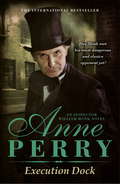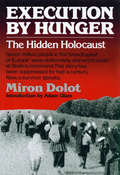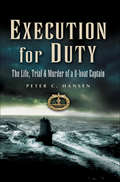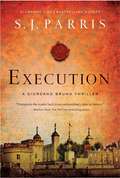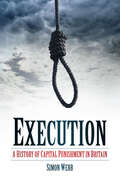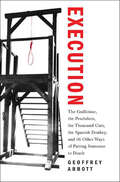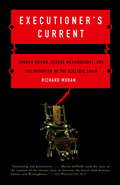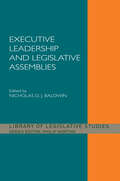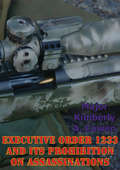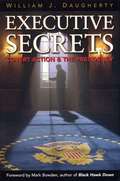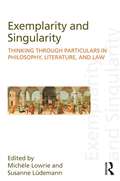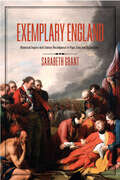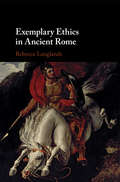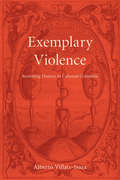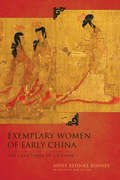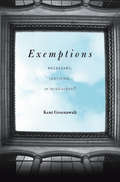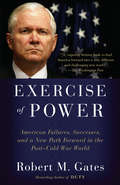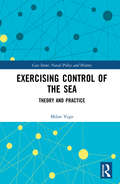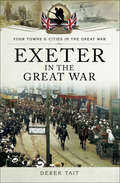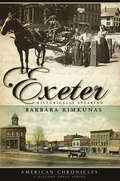- Table View
- List View
Execution Dock: A gripping Victorian mystery of corruption, betrayal and intrigue (William Monk Mystery #16)
by Anne PerryHas Monk met his most dangerous and elusive opponent yet? The death of a young boy leads Monk into one of his most dangerous cases yet in the sixteenth book in Anne Perry's brilliant William Monk series Execution Dock. Perfect for fans of C. J. Sansom and Arthur Conan Doyle.'Rich in plot development, believable characters and period detail, this entry will only add to the already sizable ranks of Perry's admirers' - Publishers Weekly It's 1864, and after a game of cat and mouse, Monk has captured Jericho Phillips, the man he suspects of brutally killing a young mudlark and running an evil child prostitution ring. In bringing Phillips to justice, Monk hopes to close down the ring and avenge the memory of Durban, his old commander, who was determined to capture Philips. However, at trial justice does not prevail. Oliver Rathbone, Monk's friend, is hired anonymously to represent the accused and when he proves that vital evidence is missing, Phillips is freed. As Monk begins the investigation again, venturing deeper into London's murky underworld, he realises that Durban may have had his own reasons for pursuing Phillips, and shockingly, that secret support for Phillips may reach further into civilised society than anyone could ever have imagined... What readers are saying about Execution Dock: 'Ms Perry's books inform, entertain, and make me think...what more can a reader ask for?''[A] compelling, assiduously plotted story''Well written with a gripping story line... You really feel the dirt and squalor of Victorian London'
Execution by Hunger: The Hidden Holocaust
by Miron DolotSeven million people in the "breadbasket of Europe" were deliberately starved to death at Stalin's command. This story has been suppressed for half a century. Now, a survivor speaks. In 1929, in an effort to destroy the well-to-do peasant farmers, Joseph Stalin ordered the collectivization of all Ukrainian farms. In the ensuing years, a brutal Soviet campaign of confiscations, terrorizing, and murder spread throughout Ukrainian villages. What food remained after the seizures was insufficient to support the population. In the resulting famine as many as seven million Ukrainians starved to death. This poignant eyewitness account of the Ukrainian famine by one of the survivors relates the young Miron Dolot's day-to-day confrontation with despair and death--his helplessness as friends and family were arrested and abused--and his gradual realization, as he matured, of the absolute control the Soviets had over his life and the lives of his people. But it is also the story of personal dignity in the face of horror and humiliation. And it is an indictment of a chapter in the Soviet past that is still not acknowledged by Russian leaders.
Execution for Duty: The Life, Trial & Murder of a U-boat Captain
by Peter C. HansenA true story of betrayal and murder withing the German navy and Nazi military court is revealed in this WWII biography of a U boat Captain. In 1937, Oskar Heinz Kusch joined the German Navy. By the time he finished naval college, the Second World War had begun. Kusch volunteered to serve on U boats and, with his distinguished record, he soon gained his own command in the 2nd U boat Flotilla. Before his second operational voyage as Captain of U 154, three new junior officers joined the submarine. Confirmed Nazi patriots who constantly praised their heroes of the Reich, they were not popular aboard—especially with Kusch, who was ideologically opposed to the Nazi regime despite his military service. During that voyage, the three hatched a plan to dishonor their Captain and accuse him of treason. The trial was corrupt and rigged. No latitude was given from higher authorities and no account of his distinguished career was taken into consideration. To the amazement of the court, orders were given that Kusch was to be shot.
Execution: A Giordano Bruno Thriller (Giordano Bruno Mysteries)
by S. J. ParrisThe new historical thriller featuring Giordano Bruno—heretic, philosopher, and spy— which finds Bruno going undercover to prevent an assassination plot on Queen Elizabeth.England, 1586. A treasonous conspiracy . . . Giordano Bruno, a heretic turned spy, arrives in England with shocking information for spymaster Sir Francis Walsingham. A band of Catholic Englishmen are plotting to kill Queen Elizabeth and spring Mary Queen of Scots from prison to take the English throne in her place. A deadly trap . . . Bruno is surprised to find that Walsingham is aware of the plot—led by the young, wealthy noble Anthony Babington—and is allowing it to progress. He hopes that Mary will put her support in writing—and condemn herself to a traitor&’s death. A queen in mortal danger . . . Bruno is tasked with going undercover to join the conspirators. Can he stop them before he is exposed? Either way a queen will die; Bruno must make sure it is the right one.
Execution: A History of Capital Punishment in Britain
by Simon WebbJudicial hanging is regarded by many as being the quintessentially British execution. However, many other methods of capital punishment have been used in this country; ranging from burning, beheading and shooting to crushing and boiling to death. This book explores these types of execution in detail. Readers may be surprised to learn that a means of mechanical decapitation, the Halifax Gibbet, was being used in England five hundred years before the guillotine was invented. Boiling to death was a prescribed means of execution in this country during the Tudor period. From the public death by starvation of those gibbeted alive, to the burning of women for petit treason, this book examines some of the most gruesome passages of British history.
Execution: The Guillotine, the Pendulum, the Thousand Cuts, the Spanish Donkey, and 66 Other Ways of Putting Someone to Death
by Geoffrey AbbottIn his own darkly humorous style, Geoffrey Abbott describes the instruments used and their effectiveness and reveals the macabre origins of familiar phrases such as "gone west" or "drawn a blank," as well as the jargon of the underworld. He covers everything from the preparation of the victim to the disposal of the body. Execution is everything you ever wanted to know about the ultimate penalty---and a lot you never thought to ask. It includes such hair-raising categories as: · Cave of Roses: A rare Swedish method of execution in which the victim was confined to a cave full of snakes and poisonous reptiles.· Bastinado: Involved the victim being caned gently and rhythmically with a lightweight stick on the soles of the feet until the mental collapse and eventual death of the victim.· Sewn in an Animal's Belly: A living person is sewn into the belly of an animal and left to die.· The Spanish Donkey: This method of torture consisted of seating a victim on top of a wall that resembled an inverted "v" with weights attached to the ankles, the weights slowly increased until the victim's body split in two.· Iron Chair: The victim is tied to an iron armchair and pushed nearer and nearer to a blazing fire. · Sawn in Half: Victims are secured in a standing position, pinned between two wide boards fixed between a stake driven deep into the ground while two executioners (one on each side) would wield a long, two-handled saw downwards through the boards. Execution is a unique fascinating look at the grim and gritty history of sanctioned death.
Executioner's Current: Thomas Edison, George Westinghouse, and the Invention of the Electric Chair
by Richard MoranIn this amazing story of high stakes competition between two titans, Richard Moran shows how the electric chair developed not out of the desire to be more humane but through an effort by one nineteenth-century electric company to discredit the other. In 1882, Thomas Edison ushered in the "age of electricity" when he illuminated Manhattan's Pearl Street with his direct current (DC) system. Six years later, George Westinghouse lit up Buffalo with his less expensive alternating current (AC). The two men quickly became locked in a fierce rivalry, made all the more complicated by a novel new application for their product: the electric chair. When Edison set out to persuade the state of New York to use Westinghouse's current to execute condemned criminals, Westinghouse fought back in court, attempting to stop the first electrocution and keep AC from becoming the "executioner's current." In this meticulously researched account of the ensuing legal battle and the horribly botched first execution, Moran raises disturbing questions not only about electrocution, but about about our society's tendency to rely on new technologies to answer moral questions. From the Trade Paperback edition.
Executive Leadership and Legislative Assemblies (Library Of Legislative Studies)
by Nicholas D. J. BaldwinThe relationship between a head of government (head of the executive branch) and a nation's parliament or legislative assembly (the legislative branch) has long been the focus for comment and analysis - for example, has the prime minister in the United Kingdom come to a position of dominance at the expense of the power of parliament? Does the American president stand head and shoulders above Congress? Is a French president master of the system? Need the Russian president pay attention to the Duma? What of the position in other parliamentary and presidential systems?In this book, Baldwin seeks to provide answers, and does so by drawing upon the knowledge and expertise of an international group of scholars whose essays advance our knowledge of the subject.This book was previously published as a special issue of the Journal of Legislative Studies.
Executive Order 1233 And Its Prohibition On Assassinations
by Major Kimberly A. CowenThrough an executive order, the United States forfeited assassination as an instrument of foreign policy. Many Americans believe that the prohibition limits our flexibility in dealing with national security threats, specifically asymmetric threats from rogue leaders. This thesis is an examination of Executive Order 12333 and its prohibition on assassination. This paper further details both legal and moral arguments, for and against assassination. The legal provisions of Executive Order 12333, the Hague and Geneva Conventions, and United Nations Charter will be reviewed. The moral dilemma of assassination will also be discussed. This thesis will address the question of whether the United States can assassinate an individual who poses a threat to its national security and interests. The author concludes that the United States should reserve the option of assassination of its threats as a tool of foreign policy.
Executive Politics in Times of Crisis
by Martin Lodge Kai WegrichExecutive Politics in Times of Crisis brings together leading international scholars to consider key trends and challenges that have defined executive politics over the past decade. It showcases key debates in executive politics and contributes to an understanding of the 'executive factor' in political life.
Executive Power in Theory and Practice
by Gary L. Mcdowell Terry L. Price Hugh LiebertSince September 11, 2001, long-standing debates over the nature and proper extent of executive power have assumed a fresh urgency. In this book eleven leading scholars of American politics and political theory address the idea of executive power.
Executive Secrets: Covert Action and the Presidency
by Mark Bowden William J. DaughertyA frank and refreshing evaluation of several Chief Executives, their Directors of Central Intelligence, and even some lover in the hierarchy, Executive Secrets shines light on the development and execution of foreign policy through the understanding of the tools available, of which covert action may be least known and understood. This book is a great tool for the press, the public, and many political appointees in the National Security System. A History Book Club Selection with a foreword by Mark Bowden, author of Black Hawk Down.
Exemplarity and Singularity: Thinking through Particulars in Philosophy, Literature, and Law
by Susanne Lüdemann Michele LowrieThis book pursues a strand in the history of thought – ranging from codified statutes to looser social expectations – that uses particulars, more specifically examples, to produce norms. Much intellectual history takes ancient Greece as a point of departure. But the practice of exemplarity is historically rooted firmly in ancient Roman rhetoric, oratory, literature, and law – genres that also secured its transmission. Their pragmatic approach results in a conceptualization of politics, social organization, philosophy, and law that is derived from the concrete. It is commonly supposed that, with the shift from pre-modern to modern ways of thinking – as modern knowledge came to privilege abstraction over exempla, the general over the particular – exemplarity lost its way. This book reveals the limits of this understanding. Tracing the role of exemplarity from Rome through to its influence on the fields of literature, politics, philosophy, psychoanalysis and law, it shows how Roman exemplarity has subsisted, not only as a figure of thought, but also as an alternative way to organize and to transmit knowledge.
Exemplary England: Historical Inquiry and Literary Recompense in Pope, Gray, and Richardson
by Sarabeth GrantWhat meaning does the past hold for the present? History writing often prioritizes the ethos and actions of the "great men" of the past, those connected to formal expressions of power, as models worthy of imitation. The problem with such exemplars is that they craft a limited view of national identity, drawn from political, economic, religious, and social institutional superstructures. Inherently exclusionary, narratives of exemplary men inadequately represent the complexities of a metropolitan and diverse society.In Exemplary England, Sarabeth Grant explores three canonical texts of 1740s England that critique the class, geography, and gender assumptions of the exemplar model. Through original readings of Alexander Pope, Thomas Gray, and Samuel Richardson, she locates practices of constituting history and registering national identity in eighteenth-century England beyond that tradition. Her book argues that these literary texts offer recompense for the national injustices endured by the disenfranchised, charting the development of inward historical consciousness as necessary to civic stability.
Exemplary Ethics in Ancient Rome
by Rebecca LanglandsThis ground-breaking study conveys the thrill and moral power of the ancient Roman story-world and its ancestral tales of bloody heroism. Its account of 'exemplary ethics' explores how and what Romans learnt from these moral exempla, arguing that they disseminated widely not only core values such as courage and loyalty, but also key ethical debates and controversies which are still relevant for us today. Exemplary ethics encouraged controversial thinking, creative imitation, and a critical perspective on moral issues, and it plays an important role in Western philosophical thought. The model of exemplary ethics developed here is based on a comprehensive survey of Latin literature, and its innovative approach also synthesizes methodologies from disciplines such as contemporary philosophy, educational theory, and cultural memory studies. It offers a new and robust framework for the study of Roman exempla that will also be valuable for the study of moral exempla in other settings.
Exemplary Violence: Rewriting History in Colonial Colombia (Bucknell Studies in Latin American Literature and Theory)
by Alberto Villate-IsazaIn his seminal essay Discourse on Colonialism, Aimé Césaire asserts that colonization ultimately works to decivilize the colonizer, awakening baser, brutalizing, and dehumanizing instincts. In this crucial new study, Villate-Isaza explores the violent colonial history of the New Kingdom of Granada (modern-day Colombia and Venezuela) by examining three seventeenth-century historical accounts—Pedro Simón’s Noticias historiales, Juan Rodríguez Freile’s El carnero, and Lucas Fernández de Piedrahita’s Historia general—each of which reveals the colonizer’s reliance on the threat of violence to sustain order. Despite their attempts to convey a narrative of European political, technical, and moral superiority, these accounts reveal tensions between the writers’ social interests and personal identifications. As they attempt to reinforce the principal tenets of European civilization and Catholic Reformation orthodoxy, they also reveal contradictions that emerge when colonizers behave in barbaric ways.
Exemplary Women of Early China
by Anne Behnke KinneyWhen should a woman disobey her father, contradict her husband, or shape the policy of a ruler? According to the Lienü zhuan, or Categorized Biographies of Women, it is not only appropriate but necessary for women to offer counsel when fathers, husbands, sons, and rulers stray from virtue. The earliest Chinese text devoted to the moral education of women, the Lienü zhuan was compiled by Liu Xiang (79--8 B.C.E.) at the end of the Han dynasty (202 B.C.E.--9 C.E.) and recounts the deeds of both virtuous and wicked women. Informed by early legends, fictionalized historical accounts, and formal speeches on statecraft, the text taught generations of Chinese women to cultivate filial piety and maternal kindness and undertake such practices as suicide and self-mutilation to preserve chastity and reform wayward men. The Lienü zhuan's stories inspired artists for a millennium and found their way into local and dynastic histories. An innovative work for its time, the text remains a critical tool for mapping women's social, political, and domestic roles at a formative time in China's development.
Exemplary Women of Early China: The Lienü zhuan of Liu Xiang (Translations from the Asian Classics)
by Anne Behnke KinneyIn early China, was it correct for a woman to disobey her father, contradict her husband, or shape the public policy of a son who ruled over a dynasty or state? According to the Lienü zhuan, or Categorized Biographies of Women, it was not only appropriate but necessary for women to step in with wise counsel when fathers, husbands, or rulers strayed from the path of virtue. Compiled toward the end of the Former Han dynasty (202 BCE-9 CE) by Liu Xiang (79-8 BCE), the Lienü zhuan is the earliest extant book in the Chinese tradition solely devoted to the education of women. Far from providing a unified vision of women's roles, the text promotes a diverse and sometimes contradictory range of practices. At one extreme are exemplars resorting to suicide and self-mutilation as a means to preserve chastity and ritual orthodoxy. At the other are bold and outspoken women whose rhetorical mastery helps correct erring rulers, sons, and husbands. The text provides a fascinating overview of the representation of women's roles in early legends, formal speeches on statecraft, and highly fictionalized historical accounts during this foundational period of Chinese history.Over time, the biographies of women became a regular feature of dynastic and local histories and a vehicle for expressing and transmitting concerns about women's social, political, and domestic roles. The Lienü zhuan is also rich in information about the daily life, rituals, and domestic concerns of early China. Inspired by its accounts, artists across the millennia have depicted its stories on screens, paintings, lacquer ware, murals, and stone relief sculpture, extending its reach to literate and illiterate audiences alike.
Exemptions: Necessary, Justified, or Misguided?
by Kent GreenawaltShould laws apply to everyone, or should some people be exempt because of conflicting religious or moral convictions? Through a close study of several cases, from abortion to taxes, Kent Greenawalt demonstrates how to weigh competing values without losing sight of practical considerations like the difficulty of implementing a specific law.
Exercise of Power: American Failures, Successes, and a New Path Forward in the Post-Cold War World
by Robert M. GatesFrom the former secretary of defense and author of the acclaimed #1 best-selling memoir, Duty, a candid, sweeping examination of power in all its manifestations, and how it has been exercised, for good and bad, by American presidents in the post-Cold War world.Since the end of the Cold War, the global perception of the United States has progressively morphed from dominant international leader to disorganized entity, seemingly unwilling to accept the mantle of leadership or unable to govern itself effectively. Robert Gates argues that this transformation is the result of the failure of political leaders to understand the complexity of American power, its expansiveness, and its limitations. He makes clear that the successful exercise of power is not limited to the use of military might or the ability to coerce or demand submission, but must encompass as well diplomacy, economics, strategic communications, development assistance, intelligence, technology, ideology, and cyber. By analyzing specific challenges faced by the American government in the post-Cold War period--Iran, Iraq, Afghanistan, North Korea, Syria, Libya, Russia, China, and others--Gates deconstructs the ways in which leaders have used the instruments of power available to them. With forthright judgments of the performance of past presidents and their senior-most advisers, firsthand knowledge, and insider stories, Gates argues that U.S. national security in the future will require learning, and abiding by, the lessons of the past, and re-creating those capabilities that the misuse of power has cost the nation.
Exercise, Respiratory and Environmental Physiology: A Tribute from the School of Milano (Perspectives in Physiology)
by Guido FerrettiThis book sheds new light on the history of exercise physiology and how it essentially grew, thanks to the work of a few major Schools. Analysing and interpreting the evolution of the field, the authors focus on the School of Milano, which was founded by Rodolfo Margaria and is one of the most prominent representatives, having played a central role in promoting and advancing this field of physiology. In turn, the authors trace Margaria’s biography; under his influence, the school introduced new concepts with regard to both the energetics of muscular exercise and to human locomotion. These concepts were further developed by Margaria’s pupils and by subsequent generations. Indeed, the course that was set in Milano greatly influenced the entire history of modern physiology. Readers with a keen interest in the origins of modern concepts and technologies in exercise physiology will find this book a fascinating and informative read.
Exercises in Programming Style
by Cristina Videira LopesThe first edition of Exercises in Programming Style was honored as an ACM Notable Book and praised as "The best programming book of the decade." This new edition retains the same presentation but has been upgraded to Python 3, and there is a new section on neural network styles. Using a simple computational task (term frequency) to illustrate different programming styles, Exercises in Programming Style helps readers understand the various ways of writing programs and designing systems. It is designed to be used in conjunction with code provided on an online repository. The book complements and explains the raw code in a way that is accessible to anyone who regularly practices the art of programming. The book can also be used in advanced programming courses in computer science and software engineering programs. The book contains 40 different styles for writing the term frequency task. The styles are grouped into ten categories: historical, basic, function composition, objects and object interactions, reflection and metaprogramming, adversity, data-centric, concurrency, interactivity, and neural networks. The author states the constraints in each style and explains the example programs. Each chapter first presents the constraints of the style, next shows an example program, and then gives a detailed explanation of the code. Most chapters also have sections focusing on the use of the style in systems design as well as sections describing the historical context in which the programming style emerged.
Exercising Control of the Sea: Theory and Practice (Cass Series: Naval Policy and History)
by Milan VegoThis book explains both the strategic and the operational aspects of exercising control of the sea. The struggle for sea control consists of three mutually related and overlapping phases: obtaining, maintaining and exercising sea control. It is in the phase of exercising sea control when one’s strategic or operational success is exploited; otherwise, the fruits of victories achieved would be wasted. This work describes the strategy of a stronger side in wartime after a desired degree of control has been obtained, which is followed by a discussion on the objectives and main methods used in exercising sea control. The remaining chapters explain and analyze in some detail each of the main methods of exercising sea control: defence and protection of one’s own and destruction/neutralization of the enemy’s military-economic potential at sea, capturing the enemy’s operationally important positions ashore, destroying/weakening the enemy’s military-economic potential ashore and supporting one’s ground forces in their offensive and defensive operations on the coast. This book will be of much interest to students of strategic studies, sea power and naval history.
Exeter in the Great War (Your Towns & Cities in the Great War)
by Derek TaitExeter played a vital role during the First World War supplying men for the Army and raising funds to help troops overseas. The Mayoress and her team played a key part collecting money to aid homeless Belgian refugees in the city while also supporting other worthy causes both home and overseas. Soldiers travelling through Exeter all received food, refreshments and cigarettes due to the money raised. The city had its own battalion, 'Exeter's Own' and thousands of servicemen passed through the city on their way to northern Europe. Players at Exeter City football club were amongst the first to join the Colours and later the Footballers' Battalion (the 17th Battalion Middlesex Regiment).The effect of the war on Exeter was great. By the end of the conflict, there wasn't a family in Exeter who hadn't lost a son, father, nephew, uncle or brother. There were tremendous celebrations in the streets as the end of the war was announced but the effects of the conflict lasted for years to come.
Exeter: Historically Speaking
by Barbara RimkunasIn March 1841, as townspeople flocked to the Exeter Courthouse to view a state-of-the-art diorama of the Conflagration of Moscow, the courthouse itself went up in flames. What was dubbed the Conflagration of the Courthouse is just one of the intriguing events revisited by historian Barbara Rimkunas in this collection. Exeter was also home to a score of eccentric personalities including Dick the fire horse, whose obituary in the town paper ran longer than that of the fire chief, and the mysterious Dr. Windship, a surgeon in the American Revolution who later earned the epithet of thief, fraudster and attempted bigamist. From scandals and Scotsmen to revolutionaries and river rats, Exeter: Historically Speaking reveals the many different threads with which Exeter's vibrant historical tapestry is woven.
